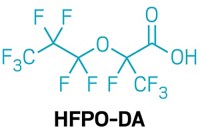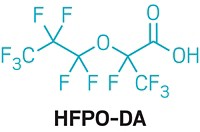Advertisement
Grab your lab coat. Let's get started
Welcome!
Welcome!
Create an account below to get 6 C&EN articles per month, receive newsletters and more - all free.
It seems this is your first time logging in online. Please enter the following information to continue.
As an ACS member you automatically get access to this site. All we need is few more details to create your reading experience.
Not you? Sign in with a different account.
Not you? Sign in with a different account.
ERROR 1
ERROR 1
ERROR 2
ERROR 2
ERROR 2
ERROR 2
ERROR 2
Password and Confirm password must match.
If you have an ACS member number, please enter it here so we can link this account to your membership. (optional)
ERROR 2
ACS values your privacy. By submitting your information, you are gaining access to C&EN and subscribing to our weekly newsletter. We use the information you provide to make your reading experience better, and we will never sell your data to third party members.
Environment
Alternative Flame Retardants Detected In Outdoor Air
Environment: Scientists measure organophosphate flame retardants at higher levels than those of the troublesome compounds they are replacing
by Janet Pelley
October 1, 2013

Manufacturers have used organophosphate esters for more than 40 years as flame retardants in items such as upholstered furniture, electronics, and plastics. The chemicals’ use has increased over the past decade as manufacturers have phased out brominated flame retardants due to environmental and human health concerns. A new study measures organophosphate flame retardants in outdoor air at levels 100 to 1,000 times higher than the brominated flame retardants they are replacing (Environ. Sci. Technol. Lett. 2013, DOI: 10.1021/ez400034n). The study suggests that organophosphate esters, which also have raised health concerns, are more persistent and get transported more easily in the environment than once thought.
In 2004, manufacturers volunteered to find alternatives to flame retardants known as polybrominated diphenyl ethers (PBDEs), following two decades of research linking them to neurological damage and endocrine disruption. Manufacturers replaced them in part with a range of organophosphate esters. Cell-based studies have suggested that some of these compounds could be carcinogenic (Science 1978, DOI: 10.1126/science.347576) and neurotoxic (Toxicol. Appl. Pharmacol. 2011, DOI: 10.1016/j.taap.2011.01.005). Nevertheless, studies in the 1980s concluded that most of these compounds hydrolyze easily, so researchers thought they would break down in the environment and not pose much harm.
However, scientists started to pay more attention to organophosphate flame retardants about five years ago after researchers found the compounds in indoor dust and human blood and milk. Because the compounds appeared to travel readily in indoor environments, “we concluded that we needed a comprehensive look at organophosphate flame retardants in outdoor air,” says Amina Salamova, an environmental chemist at Indiana University, Bloomington. “That’s the main pathway for compounds to move through ecosystems.”
Salamova and her colleagues analyzed air samples from five sites in the Integrated Atmospheric Deposition Network (IADN), a project to monitor air quality in the Great Lakes region. The scientists collected samples for 24 hours every 12 days from March to December 2012. They analyzed the particulates in the samples with electron impact gas chromatographic mass spectrometry, looking for 12 organophosphate flame retardants.
The concentrations for the 12 compounds ranged from 120 to 2,100 pg per m3. Those levels were 100 to 1,000 times higher than PBDE levels in the region measured through IADN. “In fact, these organophosphate levels are higher than any historic levels of PBDEs measured during their active production and use,” Salamova says.
Although the remote sites had lower concentrations of organophosphate esters than the urban sites, the levels were not as low as expected. “Organophosphate esters are supposed to have a half-life of a day or more,” says Rainer Lohmann, a geochemist at the University of Rhode Island. “Therefore you expect to see a strong decrease in concentration as you move away from large urban sources.” More studies are needed to explain why the compounds are more persistent in the environment than earlier thought, he says.
The data show that organophosphate flame retardants are escaping in large quantities from home and office products, suggesting that human exposure is likely, says Heather M. Stapleton, an environmental chemist at Duke University. What’s more, she says, “because the study detected organophosphate flame retardants in remote areas around the Great Lakes, it means they have the potential to be transported on global and regional scales.” High concentrations and long-range transport are tell-tale characteristics for chemicals that persist in the environment and bioaccumulate in food webs. Such chemicals often are candidates for regulation, she says.





Join the conversation
Contact the reporter
Submit a Letter to the Editor for publication
Engage with us on Twitter